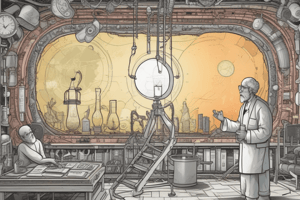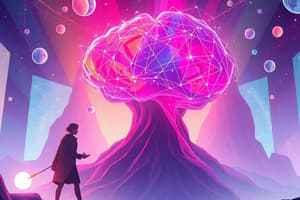Podcast
Questions and Answers
What is the primary purpose of a hypothesis in an experiment?
What is the primary purpose of a hypothesis in an experiment?
- To state the cause in an experiment.
- To measure the effects after experimentation.
- To predict the outcome of the experiment. (correct)
- To keep variables constant during the experiment.
Which statement best describes homeostasis?
Which statement best describes homeostasis?
- The process by which organisms respond to environmental changes.
- The ability to adapt over time through evolution.
- The method of energy utilization in living organisms.
- The maintenance of stable internal conditions within an organism. (correct)
What characteristic distinguishes viruses from living organisms?
What characteristic distinguishes viruses from living organisms?
- Viruses have cellular structures.
- Viruses reproduce only inside of living cells. (correct)
- Viruses can maintain homeostasis without a host.
- Viruses can reproduce independently of hosts.
What is the role of a vaccine in relation to diseases?
What is the role of a vaccine in relation to diseases?
What was one significant contribution of Carolus Linnaeus to biology?
What was one significant contribution of Carolus Linnaeus to biology?
How do bacterial diseases differ from viral diseases in terms of treatment?
How do bacterial diseases differ from viral diseases in terms of treatment?
Which cycle of a virus involves the integration of viral genetic material into the host's DNA?
Which cycle of a virus involves the integration of viral genetic material into the host's DNA?
What is the significance of a dichotomous key in biology?
What is the significance of a dichotomous key in biology?
What is the main purpose of maintaining constants in an experiment?
What is the main purpose of maintaining constants in an experiment?
In which of the following forms do vaccines expose a person to a virus?
In which of the following forms do vaccines expose a person to a virus?
What distinguishes the lytic cycle from the lysogenic cycle in viruses?
What distinguishes the lytic cycle from the lysogenic cycle in viruses?
Which component of a virus provides it with the ability to infect host cells?
Which component of a virus provides it with the ability to infect host cells?
Why is the two-name system of nomenclature advantageous in biology?
Why is the two-name system of nomenclature advantageous in biology?
Which statement best explains the role of genetic material in living organisms?
Which statement best explains the role of genetic material in living organisms?
What is one major difference in the immune response created by Jenner's and Salk's vaccines?
What is one major difference in the immune response created by Jenner's and Salk's vaccines?
Which of the following describes a common feature of RNA viruses?
Which of the following describes a common feature of RNA viruses?
Which statement accurately describes the term 'homeostasis'?
Which statement accurately describes the term 'homeostasis'?
What was Louis Pasteur's contribution to disproving spontaneous generation?
What was Louis Pasteur's contribution to disproving spontaneous generation?
What is meant by the 'effect' in an experiment?
What is meant by the 'effect' in an experiment?
Which of the following statements accurately describes the purpose of keeping things the same in an experiment?
Which of the following statements accurately describes the purpose of keeping things the same in an experiment?
What is the role of a vaccine in immune response?
What is the role of a vaccine in immune response?
Which of the following statements describes the lytic cycle?
Which of the following statements describes the lytic cycle?
What is the function of a dichotomous key in biology?
What is the function of a dichotomous key in biology?
How do bacterial diseases typically differ from viral diseases in terms of treatment?
How do bacterial diseases typically differ from viral diseases in terms of treatment?
What is the primary cause of more frequent mutations in RNA viruses compared to DNA viruses?
What is the primary cause of more frequent mutations in RNA viruses compared to DNA viruses?
Which statement accurately reflects the concept of homeostasis?
Which statement accurately reflects the concept of homeostasis?
What is a key characteristic of viruses as described in the content?
What is a key characteristic of viruses as described in the content?
Study Notes
Experiment Terms
- Independent Variable: The "cause" in an experiment.
- Dependent Variable: The "effect" in an experiment. It is what you measure in the end.
- Hypothesis: A prediction written as an "if and then" statement.
- Conclusion: A response to the hypothesis. States whether or not the hypothesis was supported by the data.
- Control Variables: Things that are kept the same in an experiment. They help to minimize unwanted variables.
Characteristics of Life
- Genetic Material (DNA/RNA): Includes instructions for inheritance and cellular processes.
- Reproduction: The ability to create offspring.
- Cells: The basic unit of life.
- Growth and Development: Increase in size and complexity.
- Respond to the Environment: Reactions to stimuli.
- Use Materials for Energy: Obtaining and processing nutrients.
- Adapt to the Environment (Evolution): Populations change over time to survive in their environment.
- Maintain Homeostasis: Regulating internal conditions.
Viruses
- Structure: Extremely small, geometric in shape, no cell parts, contain genetic material and a protein coat.
- Reproduction: Can only reproduce inside living cells (parasitic).
- Specificity: Each virus infects specific organisms or cell types.
Virus Parts
- Genetic Material: DNA or RNA
- Protein Coat: Called a capsid
Examples of Viral Diseases
- Smallpox
- Covid-19
- Chickenpox
- Ebola
- Influenza (flu)
- Common cold
- Polio
- Measles
Viral Transmission
- Bodily fluids
- Aerosol
- Physical contact
Viral vs. Bacterial Diseases
- Bacterial Diseases can be eliminated with antibiotics.
- Viral Diseases can only be prevented through the use of vaccines.
- Viral Disease Symptoms can be treated (although not the virus itself.)
Vaccines
- Jenner & Salk: Both developed vaccines. Jenner's vaccine was for smallpox and required exposure to a less harmful virus for immunity. Salk developed a polio vaccine that did not require exposure to any virus.
- Vaccine Function: A vaccine exposes a person to a weakened or "killed" form of a virus, stimulating an immune response and antibody production.
Viral Mutation
- RNA viruses: RNA viruses are more prone to mutations, leading to changes in their appearance.
Viral Infection Cycles
- Lytic Cycle: The virus enters the cell, replicates, and lyses (bursts) the cell, releasing new viruses.
- Lysogenic Cycle: The virus integrates its genetic material into the host cell’s DNA, remaining dormant until triggered.
Dichotomous Key
- A series of paired statements used to identify an unknown organism.
Linnaeus
- Carl Linnaeus: Developed the system of binomial nomenclature.
Classification Hierarchy
- Kingdom, Phylum, Class, Order, Family, Genus, Species
Binomial Nomenclature
- Two-Name Naming System: A two-part scientific name for each species, consisting of the genus and the species.
- Latin Use: Used because it was the language of academia, eliminating the problem of different regional names for the same organism.
Species
- Species: The most specific level of classification.
Spontaneous Generation
- Francesco Redi: Disproved spontaneous generation using the scientific method.
- Spontaneous Generation: The theory or belief that life can arise from non-living matter.
Experiments
- Cause: The factor that is changed or manipulated in an experiment.
- Effect: The outcome or result measured in an experiment.
- Hypothesis: A testable prediction written in an "if, then" statement.
- Conclusion: A statement based on data, supporting or refuting the hypothesis.
- Control Variables: Factors kept constant to minimize unwanted influences on the experiment.
Characteristics of Life
- Genetic Material: Contains instructions for an organism's traits and functions.
- Reproduction: The ability to produce offspring.
- Cells: The basic building blocks of all living organisms.
- Growth and Development: Increase in size and complexity over time.
- Response to the Environment: Adjusting to changes in surroundings.
- Use Materials for Energy: Obtaining and utilizing energy to sustain life.
- Adapt to the Environment: Evolutionary changes in populations over time.
- Maintain Homeostasis: Keeping internal conditions stable despite external fluctuations.
Viruses
- Structure: Extremely small, geometric shape, no cell parts, composed of genetic material and a protein coat (capsid).
- Reproduction: Reproduce only within living cells.
- Parasitic: Require a host cell to survive.
- Specific: Each virus infects specific types of cells.
Viral Diseases
- Examples: Smallpox, COVID-19, Chickenpox, Ebola, Influenza (Flu), Common Cold, Polio, Measles.
- Transmission: Bodily fluids, aerosols, physical contact.
- Treatment: Viruses cannot be eliminated by antibiotics, but vaccines can prevent them. Symptoms can be treated.
Vaccines
- Purpose: Exposes a person to a weakened or killed form of a virus, triggering the immune system to produce antibodies.
- History: Edward Jenner developed the first vaccine for smallpox. Jonas Salk created the polio vaccine.
- RNA Viruses: More prone to mutations, potentially changing their appearance.
Viral Replication
- Lytic Cycle: Virus infects a cell, replicates rapidly, and destroys the host cell.
- Lysogenic Cycle: Virus integrates its genetic material into the host cell's DNA, remaining dormant until activation.
Classification
- Dichotomous Key: A series of paired statements used to identify organisms based on characteristics.
- Carolus Linnaeus: Developed the binomial nomenclature system for naming organisms.
- Taxonomic Hierarchy: Kingdom, Phylum, Class, Order, Family, Genus, Species.
- Binomial Nomenclature: Two-name naming system (Genus species) used to ensure consistent naming.
- Species: A group of organisms that can interbreed and produce fertile offspring.
Spontaneous Generation
- Disproved by Louis Pasteur: Using the scientific method, Pasteur demonstrated that life cannot arise from non-living matter.
- Spontaneous Generation Theory: The belief that life can emerge spontaneously from non-living matter.
Experiments
- Independent Variable: The cause in an experiment.
- Dependent Variable: The effect in an experiment. It’s what you measure.
- Hypothesis: A prediction written as an "if and then" statement.
- Conclusion: A response to the hypothesis, stating if it’s supported by the data.
- Control Variable: Things kept the same. They minimize unwanted variables.
Characteristics of Living Things
- Reproduction: Organisms produce offspring.
- Cellular Organization: Living things are made of cells.
- Growth and Development: Organisms increase in size and complexity.
- Respond to the Environment: Organisms react to stimuli.
- Use Materials for Energy: Organisms obtain and use energy.
- Adaptation: Populations adapt to the environment over time through evolution.
- Maintain Homeostasis: Organisms maintain a stable internal environment.
Viruses
- Structure: Extremely small, geometric in shape, no cell parts, genetic material, protein coat called a capsid.
- Reproduction: Only reproduce inside living cells.
- Nature: Parasitic.
- Specificity: Viruses are specific to the type of cell they infect.
- Genetic Material: Contain either DNA or RNA.
- Examples: Smallpox, COVID-19, chickenpox, Ebola, influenza, the common cold, polio, measles.
Viral Infections
- Transmission: Viruses spread through bodily fluids, aerosol, and physical contact.
- Treatments: Bacterial diseases can be eliminated with antibiotics. Viral diseases can only be prevented with vaccines, and their symptoms can be treated.
Vaccine Development
- Jenner and Salk: Both developed vaccines. Jenner's vaccine was for smallpox, and Salk's vaccine was for polio.
- Jenner's Approach: Used a less harmful virus to protect against a more severe virus.
- Salk's Approach: Eliminated the need to get sick from anything to be protected.
Vaccines
- Mechanism: Vaccines expose a person to a weakened or "killed" form of a virus, stimulating an immune response and antibody development against the virus.
- RNA Virus Mutability: RNA viruses are more susceptible to mutations, changing their appearance.
Viral Reproduction
- Lytic Cycle: The virus rapidly reproduces and destroys the host cell.
- Lysogenic Cycle: The viral DNA integrates with the host cell’s DNA, remaining dormant until triggered to enter the lytic cycle.
Classification
- Dichotomous Key: A series of paired statements used to identify unknown organisms.
- Linnaeus: Devised a system for classifying organisms.
- Linnaean Hierarchy: Kingdom, phylum, class, order, family, genus, species.
- Importance of Linnaean System: Eliminated regional name variations and used a common language in academia.
- Binomial Nomenclature: A two-name naming system.
- Species: The most specific level of classification.
Spontaneous Generation
- Redi's Experiment: Disproved spontaneous generation using the scientific method.
- Spontaneous Generation: The belief that life can arise from non-living matter.
Studying That Suits You
Use AI to generate personalized quizzes and flashcards to suit your learning preferences.
Related Documents
Description
This quiz covers essential terms related to experiments and the characteristics of life. You'll explore key concepts such as independent and dependent variables, hypotheses, and control variables, along with the fundamental traits that define living organisms. Test your understanding and deepen your knowledge of biological sciences.




